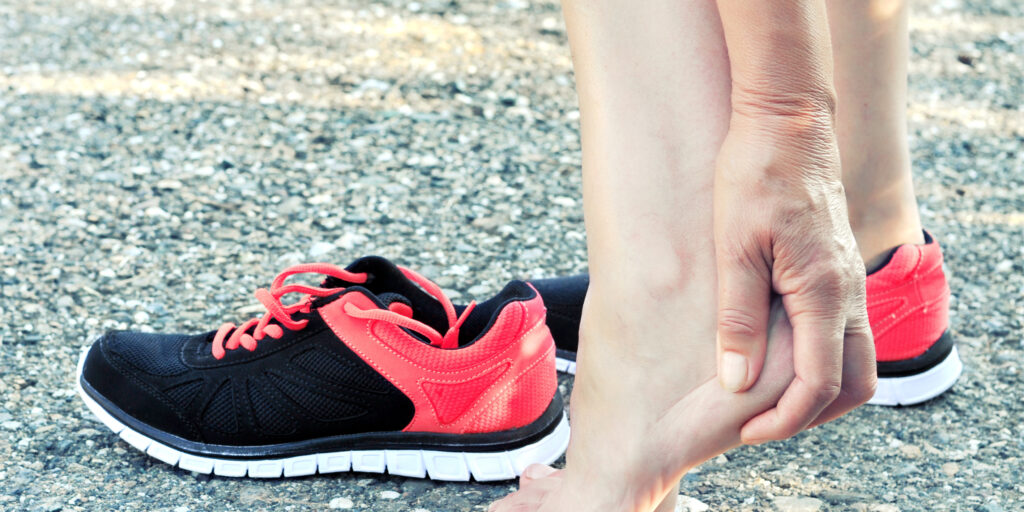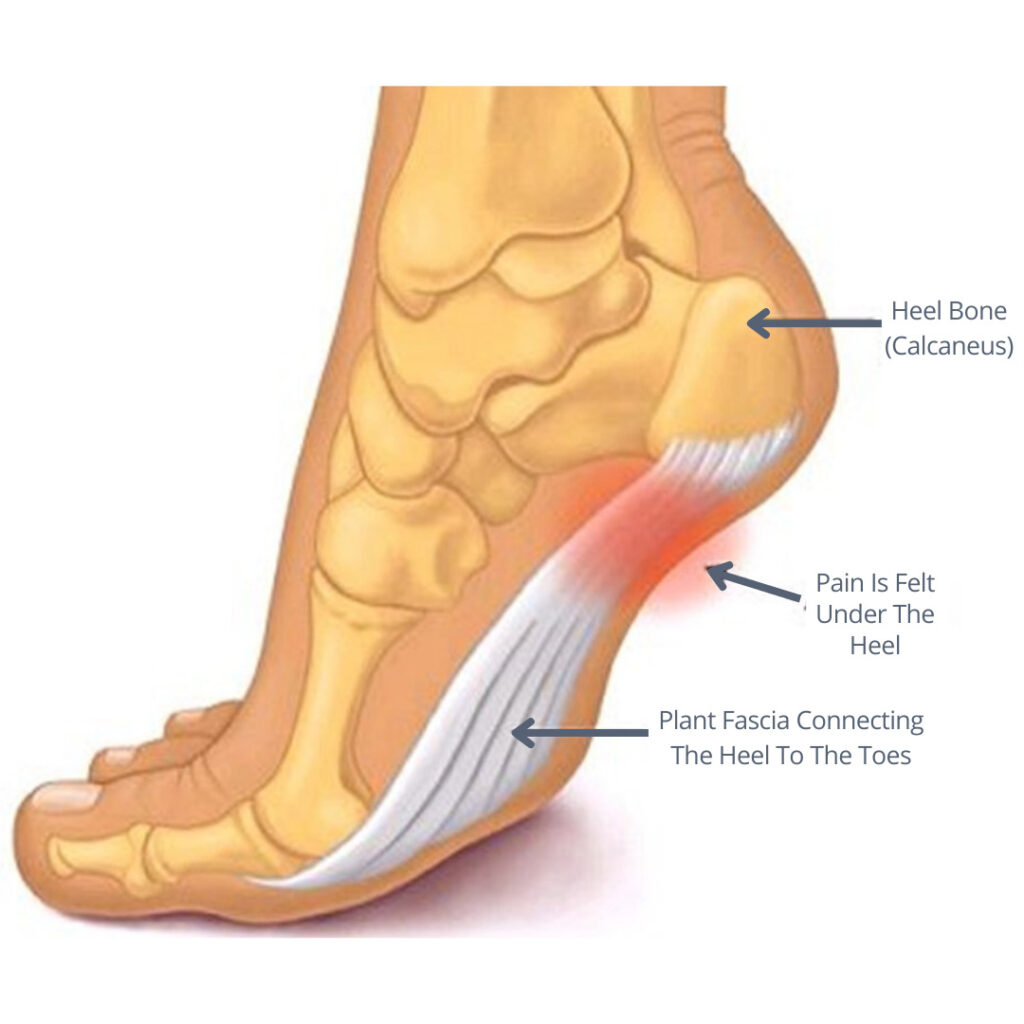
Heel pain is a common problem in runners. Plantar Fasciitis is one of the most common causes of heel pain, producing pain that is felt underneath the heel and may spread down along the arch of your foot. It often happens after increasing your running volume (also called “a spike in training load”), or when starting running after a break.
What Is The Plantar Fascia?

The plantar fascia is a thick band of tissue that runs across the bottom of your foot, connecting the heel bone to the toes. Its role is to help support the arch of your foot. Think of it like the Sydney Harbour bridge – the plantar fascia is like the roadway that connects the two ends of the arch, helping to hold them at the right distance apart. Plantar fasciitis is when this band of tissue is overloaded and becomes damaged and inflamed. In some cases there is not much inflammation going on, so the term plantar fasciopathy is sometimes used to indicate tissue damage without a significant inflammatory component.
What Does Plantar Fasciitis Pain Feel Like?
Plantar fasciitis pain is usually a sharp stabbing pain felt under the heel. It may also spread down into the inner arch of your foot. It is usually worse after being inactive or off your feet for a while, so it is generally worst in the morning for the first few steps, or after sitting still then getting up to walk. The pain usually improves as you move and warm up, but if the condition gets worse the pain can persist for longer or start to get sore again after being on your feet or running for a while. If left untreated the pain can become very persistent and eventually force you to stop running or exercising.
Risk Factors For Plantar Fasciitis
The cause of plantar fasciitis is fairly poorly understood, and it is likely that many factors are involved. The most common factor that we see as running phyisos is an increase in running volume. This can be a spike in training load, for example increasing your running frequency or distance too quickly. It can also be in new runners who try to run too much too quickly, or seasoned runners who are getting back into running after a break, for example due to a holiday or a forced break due to injury. In these cases, load management – i.e. adjusting your running volume and slowing down your training progression – is very important. Hill runs can also aggravate plantar fasciitis, so reducing these may also be part of your treatment program.
Other factors that have been shown to increase a persons risk of developing plantar fasciitis include;
– Age: Plantar fasciitis is most common in people aged between 40 and 60
– Being Overweight: Excess weight puts more stress on your plantar fascia, increasing your risk
– Some Types Of Exercise: Activities and exercise that involve a lot of running and jumping increase your risk of plantar fasciitis. This includes running (middle- and long- distance), basketball, netball, football (AFL and rugby league), and rugby. Some types of dance also have a higher incidence, for example ballet
– Foot Mechanics/Position: The research on the effect of foot mechanics on plantar fasciitis is still being developed, but in general having very flat feet or a very high arch puts added stress on the plantar fascia and can increase your risk.
– Some Occupations: Jobs that involve extended time standing or walking have a higher incidence of plantar fasciitis. This includes some retail and hospitality workers, factory workers and teachers.
Physiotherapy Treatment For Plantar Fasciitis Heel Pain In Runners
Your treatment program for plantar fasciitis needs to be personalised for your particular situation. Your physio will take in to account things such as your injury history, running goals/target races, running gait, foot biomechanics and overall strength and fitness.
If your current pain levels are quite high initial treatment will really focus on reducing your symptoms. Whilst we try to keep runners running at some level while they recover whenever possible, you may need to have a period off running and replace it with cross-training on a bike or swimming. We may also use tape to unload your fascia, and sometimes icing or rolling to help relieve pain.
Once your symptoms are at an acceptable level, your management program will commonly focus on four key areas;
1. Load Management
Adjusting your running volume (i.e. the frequency and distance/time of your runs), plus the type of runs you do (hills, speed sessions etc…) is an essential part of treating heel pain. Many cases of plantar fasciitis, as well as other common running injuries, are at least partly due to overloading tissues. Complete rest is usually NOT the answer, but reducing the load or running volume, and then gradually building back up again once your pain has settled, is an important part of your physio program.
2. Exercise
A running physio can prescribe the right exercise program for you. Doing the right exercise is essential to manage your current pain, and also to protect you against similar problems in the future. The three exercises shown here are only a small selection of exercises that we use regularly with runners.
It is ok to feel a small degree of discomfort or pain with these – think about a 2-3/10 pain level that settles fairly easily once you complete the exercise. They don’t have to be fully pain-free, but we don’t want to increase symptoms beyond the 2-3/10 level if they persist for very long after the exercise, or if you feel they increase your morning pain the next day.
These exercises help you build strength in your calf and also put the appropriate tension through your plantar fascia to help it help and increase resilience. A normal starting routine would be 3 sets of 10, on 3 days per week, and increase your volume as you improve. You can also add/increase weight to the exercises to keep progressing.
Heel Pain Exercise 1: Calf Raise With Rolled Towel
Heel Pain Exercise 2: Weighted Calf Raise With Toe Lift
Heel Pain Exercise 3: Mountain Climbers Against A Wall
3. Running Gait Analysis And Correction
Running with incorrect form can increase your risk of many running injuries, including heel pain/plantar fasciitis. Seeing a running physio who can get you on a treadmill, analyse your running gait and then help you improve your running biomechanics is an important part of managing your current heel pain as well as reducing your risk of future problems. It is also one of the most effective ways to improve your running performance!
4. Wear The Right Shoes
Finding the right shoe for you is important. There is no “best shoe” that is the right shoe for all runners – you need to find what feels good for you. Speaking to a running shoe specialist who can check your foot position and let you try a range of possible shoe options that may suit you is a great idea. Even if you have low arches/flat feet it doesn’t necessarily mean you’ll feel the best in really supportive (anti-pronation or motion control) shoes. What feels great to one runner may feel too low, high, soft or hard to another, even if they have similar foot positions.
Physio Treatment For Heel Pain In Runners – Sydney Running Physiotherapists
Our experienced team of running physios are here to help runners of all abilities get the most out of their running. If heel pain is stopping you running or affecting your runs click below to ask us a question or book an appointment online, or call us on 9280 2322.

